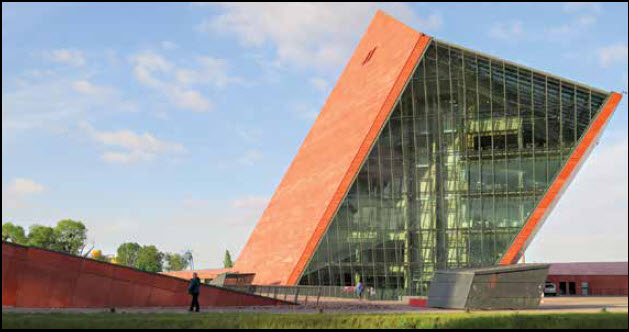 By: Sandra Thompson
By: Sandra Thompson
One of the first places to go when visiting Gdansk is the “Muzeum II Wojny Swiatowej” (Museum of the Second World War.) It should be noted that Poland does museums exceptionally well. This purpose-built museum complex is striking. Surrounding the building is a flat, neatly landscaped plaza. Above it rises a jagged, glass-and-rusted-steel tower. The museum occupies in excess of 50,000 square feet, entirely underground providing a somber tomb-like atmosphere, or perhaps something like a mausoleum. It seems a fitting venue to delve into the history of WWII.
This history is presented in a manner allowing visitors to unravel all the political, social, and cultural strands and begin to make sense for those who know little about this east-central nation and the real location of the start of the war: Gda?sk, or Danzig as it was called by the invading Germans. And it is done in such a way to emphasize the not often recognized bravery of the Polish people.

Inside, the exhibits wind along a central corridor, detailing the events and factions engaged throughout the struggle during World War II. The tour begins with an explanation of the artificial peace created with the ending of WWI. The museum makes maximum use of available artifacts, woven together through employment of modern techniques, touchscreens, and elaborate recreations. The tour includes a stroll down a Polish city street, before and after the war.
The museum’s displays stir powerful emotions: A boxcar used to transport Jews to concentration camps. A wooden wheelchair from a psychiatric hospital near Gda?sk, all of whose patients were euthanized by the Nazis. An actual Enigma machine, with an explanation on how Polish mathematicians originally broke the German code, hid from the Germans all evidence that the code had been cracked, then provided the decryption and a machine to the British…all prior to the involvement of Alan Turing and Bletchley Park. The film by American correspondent Julien Bryan, who was in Warsaw during the invasion and bore witness to the Nazis bombing a church during Mass, an attack on a maternity ward, and a village of peasants strafed by Luftwaffe gunfire while digging up potatoes. A soaring wall of suitcases symbolizes the mass deportation of European Jews to the death camps. The tattered shoe of a Polish child killed during the 1944 Warsaw Uprising focuses on the carnage against children. Porcelain melted by the atomic bomb the U.S. dropped on Hiroshima bears witness to the advent of nuclear war.
World War II claimed upwards of 55 million lives, the majority civilian, according to the museum. Some 10 million were children. Poland lost around 17 per cent of its population during World War II, giving it the highest national death toll from the conflict. The permanent exhibitions primarily focus on the experiences and suffering of civilian populations, with the military events as a backdrop. While the museum primarily focuses on the countries of East-Central Europe, there is no tunnel vision, it also examines the tragic war times from the perspective of other-world countries.
This is the museum of a war, not a military museum, which tells the story of a war in terms of politics, ideology, and civil population. The 3-4 hours I spent here were thought provoking and emotional, allowing comparison of events occurring today with those which lead to WWII. A definite must-see when in Poland. More information on the museum can be found at their website at https://muzeum1939.pl/en/
By: Sandra Thompson




